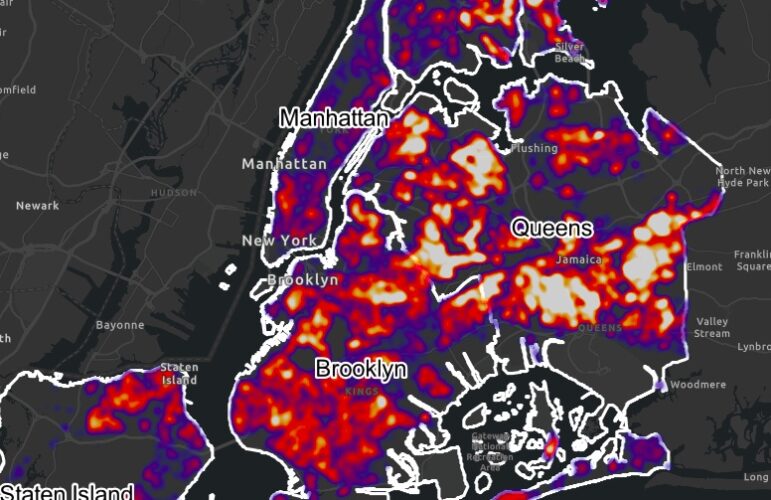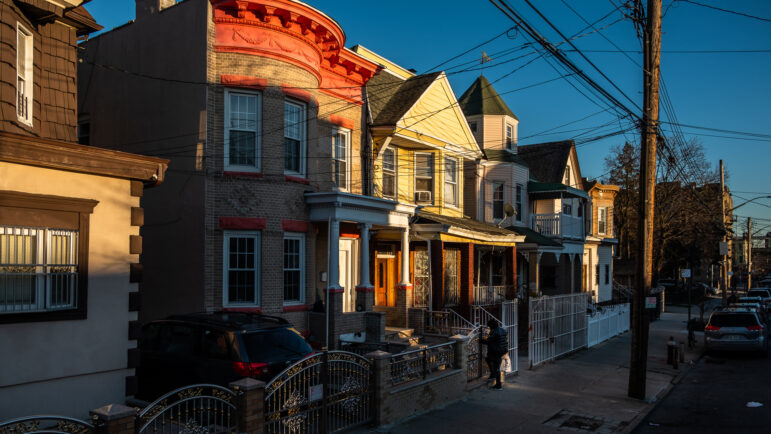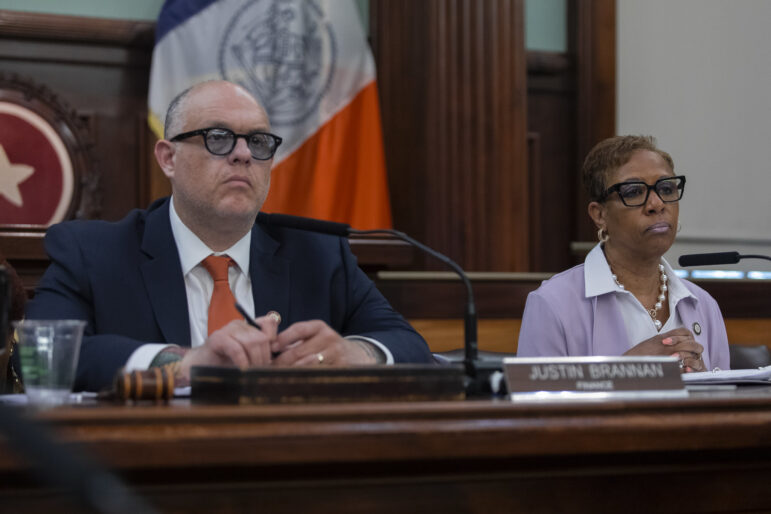‘The COVID-19 pandemic has pushed the city to the brink of a housing crisis. It is time for the city to design housing policies that retain the people who are the heart, the lungs, and the soul of New York City’

Adi Talwar
A meeting of the Flushing Rezoning Community Alliance in 2016.Bobby Nathan, a Jamaican immigrant, found his American haven 40 years ago in Flushing, Queens. The neighborhood is a cacophony of cultures, and harbors a stunning array of languages. One block alone houses a historic synagogue, a Colombian bakery, and a Cantonese restaurant. Nathan considers Flushing to be “a ladder for people to step up into the American Dream.” That ladder, however, is splintering.
Over the last two decades, Flushing has experienced a flurry of luxury development. As glistening skyscrapers rose along its waterfront, predatory landlords swept through its rental market. After Mayor Bill de Blasio signaled his intention to partially rezone Flushing in 2014, speculative activity intensified. Nathan’s neighbors suffered in this process. The building he lives in was bought twice in the last decade, both times by known predatory landlords: Treetop Development and the Pinnacle Group. Thirty-two of the building’s 90 units sit empty, their former occupants cruelly harassed out.
Equivalent scenarios can be found throughout the city. Low-income, Black, and immigrant populations are driven out of their homes as their neighborhoods gentrify. As if by design, local affordable housing policies displace these New Yorkers and drain the soul out of communities like Flushing. The COVID-19 pandemic has pushed the city to the brink of a housing crisis and shown us our utter dependency on the hard-working residents of low-income, minority neighborhoods. It is time for the city to design housing policies that retain the people who are the heart, the lungs, and the soul of New York City.
 CityViews are readers’ opinions, not those of City Limits. Add your voice today!
CityViews are readers’ opinions, not those of City Limits. Add your voice today!
In 2016, the de Blasio administration unveiled its signature affordable housing policy, Mandatory Inclusionary Housing (MIH). In a nutshell, MIH ties affordability requirements to changes in city zoning laws. MIH is triggered by individual developer’s rezoning requests and by city-initiated neighborhood rezonings: If a developer seeks to build a residential structure significantly larger than what existing zoning laws permit, they must ensure a percentage of their building’s units are affordable. Similarly, any project in a rezoned neighborhood must abide by MIH’s affordable housing requirements.
The de Blasio administration expected MIH to produce at least 12,000 affordable housing units. The policy however, has many incongruities with the populations it is intended to serve.
Chief among these is the administration’s insistence on quickly rezoning a number of working-class, minority neighborhoods.The luxury towers rising over the outer boroughs are emblematic of this process. However, rezoning-induced displacement happens before—and sometimes independently of—their glistening rise.
As is the case in Flushing, real-estate speculation tends to flourish in areas selected for up-zonings. In anticipation of an influx of market-rate or luxury development, real-estate investors and predatory landlords buy up a flurry of properties in these neighborhoods. Seonae Byeon, the lead housing organizer for the MinKwon Center for Community Action, has seen this happen in her Flushing community. Between 2014 and mid-2019, she says, predatory landlords routinely used construction as a tool to displace their primarily working-class, immigrant tenants. The staggering number of displacements, she says, are not captured in traditional eviction data because tenants—due to factors like limited English proficiency—do not fight their landlords in housing court.
The de Blasio administration ultimately withdrew its plans to rezone Flushing, but the speculative wave those plans had unleashed caused lasting damage. The salary needed to comfortably afford a studio or one-bedroom apartment in the neighborhood rose 21 percent in the last five years. Byeon fears that the sudden push for a corporate rezoning of the Flushing waterfront will keep steering the neighborhood in that direction.
City officials should not even speculate about neighborhood rezonings without first having a robust plan of action to curb real-estate speculation. Last year, Governor Andrew Cuomo signed the Housing Stability and Tenant Protection Act of 2019, curtailing landlords’ ability to use construction, vacancies, and other methods to de-stabilize apartments. However, the city must go further, particularly as we approach a COVID-related housing catastrophe.
Over the summer, millions of tenants will lose the protections and financial assistance that kept them housed at the height of New York’s outbreak. The state’s eviction moratorium has already narrowed tenant eligibility for protection, and will expire in late August. Enhanced unemployment benefits ended last week. According to an analysis conducted by NYU’s Furman Center, the rental assistance that low-income New Yorkers will need after the expiration of enhanced unemployment benefits may reach $267 million per month. The recently enacted Emergency Rent Relief Act funnels $100 million of federal CARES funding into a voucher program designed to cover rent for eligible rent-burdened, middle and low-income New York State tenants. This still leaves a shortfall of over $100 million, and because of its federal origin, excludes the undocumented New Yorkers that helped keep our communities running through the pandemic.
With our current trajectory, the city will experience a wave of tenant evictions and foreclosures among smaller landlords. This will create fertile ground for further real-estate speculation in neighborhoods, like Gowanus and Inwood, already facing rezonings. The city must not allow this to happen.
The city must invest in foreclosure prevention programs, and, in the event that small landlords cannot avoid foreclosure, tenants and non-profit developers should have the first right to purchase their properties. Furthermore, landlords with abysmal eviction records should not have the opportunity to purchase new buildings for a period of five years after the expiration of New York State’s eviction moratorium. The city and state’s coffers are, understandably, running low due to the COVID-19 crisis. The state should tax blatantly speculative real-estate transactions to help deter a flood of displacement and to help replenish its tax revenue. The city’s current affordable housing policies have all but handed neighborhoods like Flushing to real-estate speculators; policies loyal to New Yorkers would not do that.
Policies loyal to New Yorkers would also strive to paint an accurate picture of the consequences of rezonings. The City Environmental Quality Review (CEQR)—the process by which city agencies assess the potential neighborhood impacts of actions like rezonings—is spectacularly inaccurate. The Bloomberg administration’s rezoning of Williamsburg, Brooklyn is a textbook example of this. Its Environmental Impact Statements (EIS) predicted little to no demographic or affordability changes in the neighborhood following its rezoning. The actual changes were seismic. Williamsburg experienced an exodus of Latino residents, and lost 942 rent-stabilized apartments following its 2005 rezoning. Median rents rose by over $800.
The de Blasio administration insists that MIH-related rezonings will improve affordability in targeted neighborhoods. The administration uses the same inadequate CEQR as its predecessor, and similarly determines that rezoning heavily minority neighborhoods will not displace low-income residents. New Yorkers however, know better: In 2019, the residents of Inwood, Manhattan successfully challenged their neighborhood’s rezoning by attacking the CEQR process. A local judge halted the rezoning, ruling that the city had not properly assessed its possible racial and socioeconomic impacts. The city appealed the decision, and won.
The choice to appeal was, put bluntly, insulting. The CEQR’s deficiencies are well documented, and have contributed to wildfire gentrification across the city. The city should not defend and commit to a process that has displaced thousands of New Yorkers. Instead, it should commit to completely rehabilitating it. At the moment, city agencies are not mandated to follow-up on their CEQR predictions, nor to investigate any gaping inaccuracies. This has to change.
The New York City Council should move on and vote affirmatively on Int 1487-2019, a bill that would require the Department of Housing Preservation and Development to investigate discrepancies between the predicted and actual residential displacement effects of neighborhood rezonings. The Council should do the same for Public Advocate Jumaane Williams’ bill, Int 1572-2019, which would mandate a racial impact study for all land actions requiring an environmental review. Contested rezonings like that of Inwood should not proceed until they can be analyzed with a more accurate and honest instrument than the currently available CEQR.
MIH’s other structural flaw lies in its affordability requirements. Namely, these requirements are calculated in relation to the entire city’s Area Median Income (AMI), which in early 2020, stood at $113,700 for a family of four. The deepest level of affordability required from developers bound by MIH is that 25 percent of a project’s units be affordable to families making an average of 60 percent AMI ($68,220 for a family of four) with 10 percent of those units set aside for families making an average of 40 percent AMI ($45,480 for a family of four).
MIH, in essence strikes a deal with developers: they are allowed greater density and tax breaks in exchange for producing some affordable rental housing. Greater density can, over time, depress rents across the city. The current arrangement, however, can’t mitigate displacement because this housing is inaccessible to residents of many neighborhoods receiving MIH projects. While the AMI for the city is $113,700 for a family of four, the AMI in Inwood was $54,890, in Flushing it was $54,040, East Harlem’s was $33,090, and East New York’s was $42,060. The deepest affordability required under MIH excludes close to—if not more than—half of the residents of these neighborhoods that the de Blasio administration has tried to rezone.
For Byeon, Flushing is a place where immigrants can find courage and comfort. It is a place where incredibly diverse populations can build power together. The promise of Flushing, and the promise of this city, is in how the entire planet seems to have found a haven in its tangled streets. The city can’t survive without this promise and this courage: as COVID-19 ravaged the city, our Black, immigrant, and low-income New Yorkers kept it on its feet, and suffered incalculable personal losses in the process. New York’s housing policies have often betrayed our essential New Yorkers. As this city rises from the wreckage of COVID-19, it has the opportunity, and the duty, to finally create a housing environment that nurtures its people.
María Victoria Díaz-González is a Queens-based freelance journalist.










4 thoughts on “Opinion: Now More Than Ever, NYC Must Revamp its Housing Program”
Nicely put. The conclusions in this article will be the lasting legacy of Mayor de Blasio. He will forever be known as the Mayor who fed gentrification steroids and exacerbated the Tale of Two Cities that was the theme of his initial run for Mayor. But it is not too late for this administration. The Mayor can signal his support for bills currently in the Council that will expand Right to Counsel. Even with the Mayor’s recent Inwood victory, he can take a step back and agree to undertake the kind of racial and displacement assessment that Northern Manhattan Is Not For Sale has requested and sued for. As suggested in the article, the city can work with local groups to aggressively intervene in buildings where predatory owners still seek to maximize profits that are illusory at best, but will no doubt still result in evictions. That intervention should be targeted towards tenant or not-for-profit ownership. There is much more to be done, but that would require the city to open up and invite more diverse groups high level discussions. That is probably unlikely, given the make-up of the Real Estate Council formed by the Mayor’s office to help the city reopen its development operations. Who the Mayor’s Office chooses to talk to provides the biggest clue as to whose work they value. But again, there is still time to make the best of a situation that could very likely get worse.
The Co-op movement in housing has a solid history of providing affordable and stable housing in NYC. Developers don’t benefit from co-op housing, they benefit from city, state, and federal incentive programs, building bonuses for affordable apartments, and then the constant flow of rent payments, so no politician is ever asked to promote co-operative housing programs.
I’m incredibly proud of how a fellow Queens native has written this piece to highlight the need for affordable housing. City officials and corrupt forces need to be held accountable for the roles they have played in worsening the housing crisis amidst the devastation of COVID19.
Mayor WDB and his housing finance team developed a recipe for disaster in our neighborhoods while everyone (well, almost all except for us diehard preservation veterans) fell asleep and allowed this inhumane stew to cook in our kitchens. The pot was not big enough to feed our guest and was too thin to nourish to satisfy our hunger. This DeBlasio nail soup should have been canned and shelved before it got hot. East Harlem got pittance and our leadership dropped the bowl. ElBarrioUnite.org said it write and its all history now. We lost a good fight while this could have been stopped.